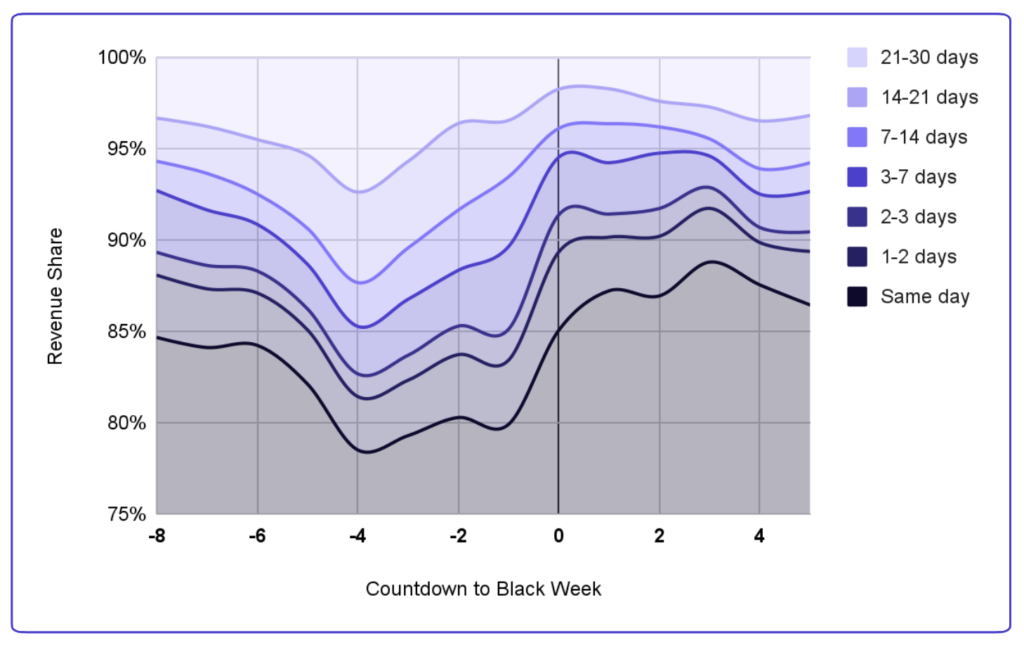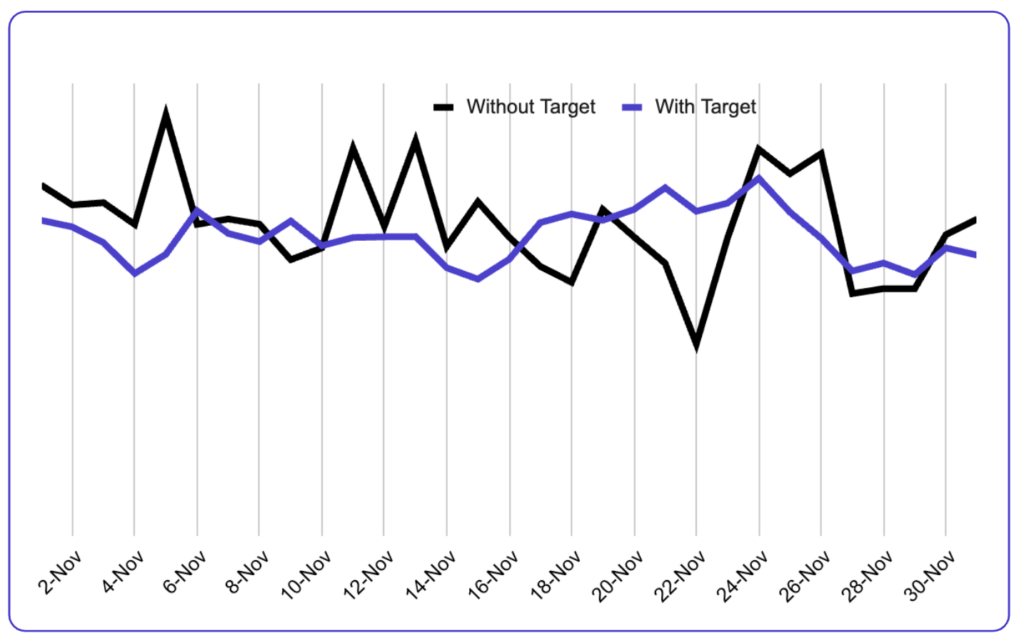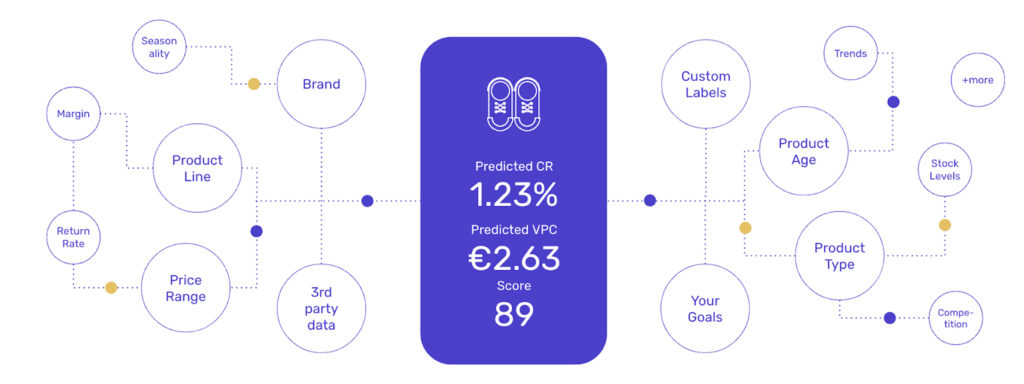Subscribe to join thousands of other ecommerce experts

With the most competitive holiday season yet fast approaching, it’s more important than ever to fine-tune your Black Friday Google Ads campaign strategy, budget allocation, and overall competitive positioning.
Following Mike Ryan’s 2024 Holiday Season Action Plan webinar, we received some great follow-up questions via email that deserve a closer look.
So let’s break them down:
Table of Contents
Black Friday Performance Max campaigns
1. What are the best practices for segmenting product groups in Performance Max campaigns to optimize both conversion value and profitability during the holiday season?
In Performance Max, the key to product group segmentation lies in balancing conversion potential and seasonal demand.
Ideally, you should segment products based on their general performance, margins, and stock availability. Grouping high-demand products—like best-sellers or limited-edition holiday items—separately allows you to adjust bids for each segment more strategically.
Additionally, you can use custom labels to organize products by sales velocity or profitability, and keep a close eye on stock levels to avoid promoting items that might sell out too quickly.
Audience signals are also pretty darn important here—so make sure you’re using them to capture high-intent shoppers, like past purchasers or people actively browsing holiday gift categories.
2. How do you recommend setting up seasonality adjustments within PMax to account for the fluctuating consumer demand during Black Week and the holiday season?
Seasonality adjustments are a must for short-term events like Black Friday. They allow you to tell Google’s algorithms to expect higher conversion rates over a limited period.
To start, look at your previous holiday data to estimate the potential uplift.
Typically, you might see a 20-30% boost in conversion rates during Black Week. You’ll want to set your adjustment window for just a few days—covering the spike—and turn it off immediately after to avoid unnecessary overspending.

Budget allocation & ROAS targets during Peak Season
1. With a significant budget of over €15k monthly, how should I adjust my ROAS targets for key dates like Black Friday and Cyber Monday to maximize profitability without sacrificing too much on ad volume?
With a large budget like €15k, you’ll want to lower your ROAS targets slightly to capture more volume during key dates like Black Friday.
At the same time, ensure to increase your budget strategically—especially during peak hours. To prevent overspend, monitor performance intra-day and adjust based on conversion spikes, which often happen later in the day.
These ROAS shenanigans can admittedly be pretty headache-inducing. Which is why we recently wrote an entire blog post about why lowering your ROAS targets can – sometimes – lead to more profitable results. You should check it out!
Awareness campaigns prime the pump. But conversions
Mike Ryan, Head of Retail Insights at smec
keep it flowing.
2. Is there a recommended split between upper-funnel awareness campaigns and lower-funnel conversion-focused campaigns during the holiday season?
The holiday season is a conversion game, and while awareness is important, your upper-funnel campaigns should have ideally done their heavy lifting in the weeks leading up to it.
By the time you’re in Black Friday territory, your budget should shift heavily towards lower-funnel efforts. Think of it like this: awareness primes the pump, but conversions keep it flowing.
- During peak periods like Black Friday or Cyber Monday, allocate 75-80% of your budget to conversion-focused campaigns.
PMax, Shopping Ads, and Search Ads should dominate here, as these campaigns are designed to drive those last-minute, high-intent purchases.
- That said, don’t completely neglect the top of the funnel. Retargeting audiences who engaged earlier in Q4 can be highly effective now.
Use 10-15% of your budget for awareness campaigns, but aim for channels like YouTube or Display where you can remarket to those who have already shown interest. These can act as final nudges to hesitant buyers.

but you can still be efficient without them.
Source: Smarter Ecommerce GmbH proprietary data
Product prioritization for the holidays
1. How can I effectively identify and promote high-potential products from my catalog of over 1,500 SKUs? Should I focus on high-margin items or best-sellers when scaling for holiday traffic?
For a catalog larger than 1,500 SKUs, a balance between high-margin items and bestsellers is a pretty surefire key to success.
- Best-sellers provide reliable conversion volume, especially during the holidays. But don’t overlook high-margin products—these can significantly boost profitability.
- Use last year’s Q4 data to identify which products sold best and at what margins. For high-margin products, try bundling them with popular items to boost their visibility and conversion potential.
Additionally, you should consider adding urgency through promotions to move these higher-margin items faster.
2. What tools or techniques would you recommend for multi-dimensional product segmentation to highlight the most profitable products in my Black Friday Google Ads?
Not gonna lie, the best tool on the market right now to segment your product catalog in multiple dimensions is our very own software. Sorry, not sorry.
Our solution automates multi-dimensional segmentation by layering factors like margin potential, stock levels, and seasonal relevance—giving you full control without the headache.
Our software lets you optimize for high-profit products at exactly the right time, ensuring your ads drive maximum-profit-potential during the holiday rush.
For a full breakdown on how this works and how you can implement it, check out our blog post on multi-dimensional segmentation here.

Black Friday Auction Insights & competitor strategy
1. How can I leverage competitor auction insights during the holiday season to adjust my bidding strategies without overspending?
Google’s Auction Insights is a goldmine of information during the holidays. Use it to monitor your impression share and overlap rate—if a competitor is consistently outranking you, they may be bidding aggressively.
Instead of entering a costly bidding war, consider focusing on less competitive products or targeting times of the day when the auction landscape is less crowded. This can help you make more informed bidding decisions and avoid unnecessary budget wastage during peak periods.
2. Are there any specific signals or benchmarks I should monitor to anticipate aggressive CPC spikes in my industry during peak shopping periods?
During peak shopping periods like Black Friday, competitors can quickly ramp up their activity. Google’s Auction Insights provides direct monitoring of competitor performance, helping you identify when aggressive CPC increases are happening.
For a broader view, use the smec Market Observer tool to track shifts in category performance over time. It allows you to see rising or falling demand within your industry and spot emerging trends. For example, if a particular category experiences a sudden surge, it might indicate increased focus from competitors.
By identifying these shifts early, you can adjust your bidding strategies and budget allocation to stay competitive without overspending.
Make this your
most profitable Peak Season with smec’s powerful PPC software!
Book a free demo! How do YOUR campaigns stack up?
Whether it’s fine-tuning your Performance Max campaigns, setting optimal ROAS targets, or leveraging competitor insights, the key to Black Friday Google Ads success lies in staying agile and data-driven.
If managing these complexities sounds overwhelming: You are not wrong. There is definitely a lot of stuff you can do to make your ads shine during peak season. Stuff that will inevitably eat into a lot of your time.
But don’t worry: our solutions can help streamline your process by automating bid adjustments, product prioritization, and competitor analysis.
Have more questions or need further guidance? Why not book a free demo?
Our PPC experts will take a closer look at your current Google Ads setup and show you the true uplift potential of your campaigns during and beyond the holiday season.

